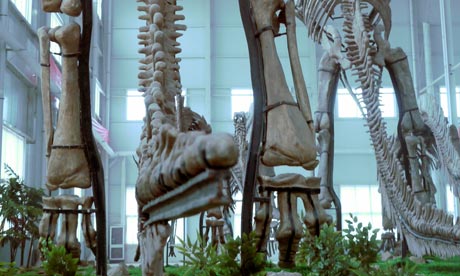
It must have been an awe-inspiring sight: four metres tall and weighing six tonnes. Its sharp teeth delivered a bone-crushing bite. Yet even "the tyrant from Zhucheng" reached its inevitable, ignominious end. Over time, half its skull was torn from its skeleton and jumbled with the bones of less imposing creatures at this site in what is now China's eastern Shandong province.
Last month – tens of millions of years later – researchers resurrected Zhuchengtyrannus magnus. Impressive though the reconstruction was, it was just one of a succession of fossil discoveries that have put this "dinosaur city" on the map.
Zhucheng's early Cretaceous relics, Liaoning's feathered dinosaurs and Xinjiang's wealth of Jurassic material are among the Chinese treasure troves reshaping our understanding of ancient life on Earth, and the processes that have created the world around us. "Some of the new material from China is breathtaking," said Dr Paul Barrett, a palaeontologist at the Natural History Museum. "Firstly, the sheer number of new species is impressive. Secondly, some of the dinosaurs that have been discovered have had major impacts on evolutionary debates."
Local legend in Zhucheng tells of battling black and white dragons: tales rooted, perhaps, in the mighty jaws and femurs found by farmers. For years, residents boiled the "dragon bones" in medicinal soups or ground them into powder.
Excavations began here in the 60s and their pace has dramatically accelerated in recent years as China has poured vast amounts of money into scientific research. More than 50 tonnes of dinosaur fossils have emerged from 30 sites around the town. One remarkable 300-metre-long bone bed has yielded more than 15,000 items. Another site is pitted with 3,000 footprints.
Making sense of it all are dinosaur hunters such as Professor Xu Xing and his colleagues at the Institute of Vertebrate Palaeontology and Palaeoanthropology at the Chinese Academy of Sciences. Xu has identified more than 30 dinosaurs and co-authored papers naming another 20 or so. "I would say I am one of the luckiest people in the world because I have continued finding great species. That makes you even more addicted; it's like smoking," he confided.
Dr David Hone, of University College Dublin, who worked with Xu for three years and led the Zhuchengtyrannus magnus research, said: "It is a phenomenal achievement, but often it is what he's done [after identification] that is the measure of the real quality of his research." In particular, Xu's work on feathered dinosaurs has shed new light on how the creatures evolved into birds. Xu was "the right person in the right place at the right time", Hone added.
It did not seem that way to Xu for many years. While western peers were modelling Plasticine stegosaurs, he grew up in a remote area of north-western Xinjiang, where education was poor. He had never heard of dinosaurs and hoped to become a physicist – but when he won a rare place at Peking University, he was assigned to palaeontology.
"Even our teacher didn't know what it was, so we thought it must be something very modern. When I found out I was very disappointed," he recalled. It took him years to learn to love his work, but now he enthuses over "beautiful", "amazing" and "bizarre" finds.
"This one might be a new dinosaur – we are trying to confirm," he explained as he compared images of skulls from various species to the squished example facing him in a Shandong museum. Boasting huge, shark-like teeth and a lengthy tail, the creature – discovered in Liaoning province – was unusually large for a feathered dinosaur. It could also, he thought, be relatively primitive.
That specimen was largely intact, but at sites such as Zhucheng's long bone bed, researchers face what Xu calls a "death sandwich". Similar species may be in the same spot; features can be distorted beyond recognition. Deciphering it is like completing multiple jigsaw puzzles – except that many pieces are missing; those that remain are mixed together; and you may or may not have the right pictures to help you. Even new features may not indicate a new species; just a different developmental stage of an existing one.
Those are not the only challenges faced by China's palaeontologists. Regulations on fossil sales and smuggling, introduced over the past decade, have curbed but not halted the trade – hardly surprising when specimens can be worth many times a farmer's annual income. Officials hope an embryonic dinosaur tourism industry will encourage residents to report finds rather than sell them. "Zhucheng's dinosaurs have become world-class stars," said Wang Kebai, the official leading its ambitious tourism projects. People love the mystery of dinosaurs, he said, and the thrill of new discoveries.
Even palaeontology's reluctant recruit admits that studying them for so long has shaped his view of the world.
"These creatures lived millions of years ago; some of them were gigantic," mused Xu. "Examining them, you sometimes feel that humans have a lot of control over nature and other things: but finally, we will all be bones."
Source from :http://www.guardian.co.uk/science/2011/may/13/chinese-dinosaur-city-prehistoric-era
For more information related to dinosaurs, visit rareresource.com.

0 comments:
Post a Comment